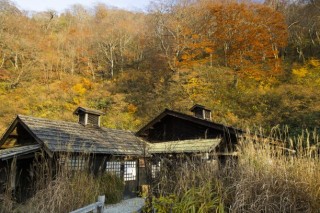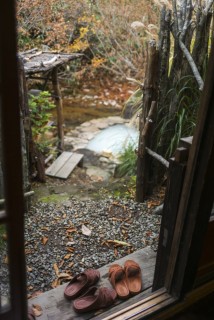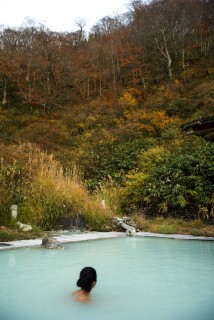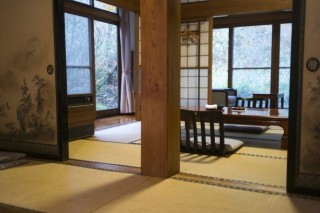Loading
Search
▼ A Visit to the Tsurunoyu Onsen
- Category:Hot spring
As our taxi driver missed the entrance and proceeded to do a U-turn in the middle of the road, I thought the gorgeous fall colors enveloping the highway around us might have mesmerized him, but I quickly realize he completely missed the turn that took us to the Tsurunoyu Onsen. We circled back around and turned down a non-descript dirt road with a small sign written in Japanese that even our locally born taxi driver didn’t catch. He nodded and said “daijobu,” or something to the effect that we’re ok and now on the right path towards the famed onsen nestled at the base of Mt. Nyuto-zan in the Towada Hachimantai National Park.
I’ve never traveled in the Akita Prefecture before and only knew the Tohoku region as the area that was struck by the devastating 2011 tsunami.
As an American tourist who has visited Japan numerous times, getting away from the hustle of Tokyo can be rewarding but most Western tourists rarely leave the capital and tend to travel exclusively to Kyoto, Osaka, Kobe, and a few other major cities south. Yet a trip north into the Tohoku region allows travelers experience the real Japanese countryside, the heart of authentic Japan. Skyscrapers give way to endless emerald green rice fields, majestic mountain views, and a Japanese friendliness that escapes those who live in the big cities.
We left Tokyo taking a three-hour trip north on the Shinkansen train from Tokyo Station to Akita. The bullet fast train dropped us off at Tazawako Station but we were still a distance from Tsurunoyu. According to the Onsen’s English website, visitors need to take an additional bus to the hot spring but Tsurunoyu suggest you call them in advance to let them know your bus departure time so they can arrange transportation to meet you at their bus stop. A walk from the bus stop to the Onsen would take over an hour so that call from the station is crucial.
Although it would cost more money, we opted for the convenience of a taxi, as we were both jet lagged and needed to travel to the next town over after our day trip to the Onsen.
As our taxi continued down the forest road, we were engulfed by fiery fall foliage, as the leaves had not yet shed from the trees. The taxi must have continued for at least another ten minutes until we finally reached what appeared to be a structure built in a different era. Tsurunoyu Onsen sat nestled at the bottom of mountain with the fall colors completely swallowing the property. Yellow reeds and birch trees obscured a water wheel slowly churning over a misty brook and the smell of sulfur signaled the mineral rich waters of the mountains awaiting us in the bath.
The onsen was established in the 1600s and was used by the local nobility and samurais of the Akita region. The original thatched roof building still stands on the property. Once frequented exclusively by local visitors in recent times, international travelers have now discovered the onsen’s magical waters. So when we arrived, we rubbed elbows with Taiwanese, Thais, Malaysians, and a few Europeans. The onsen’s isolation also did not ensure us an overnight booking as the ryokan, or guesthouse, was booked solid for weeks. However, Tsurunoyu offers a day pass and we couldn’t miss bathing in the spring’s blue waters.
After arriving and purchasing a day pass, we hit the hot springs. A visit to a Japanese bath can be daunting to many newcomers but it is an experience not to be missed. The ritual of the onsen involves showering in a communal room before entering the hot springs. You shower by squatting on an impossibly low stool that forces your knees upwards towards your ears and bathe under a waist-high showerhead. Shampoos and liquid soaps are provided in your shower stall but they’re never in English, so I always find myself conditioning my feet and body soaping my hair.
Although it would cost more money, we opted for the convenience of a taxi, as we were both jet lagged and needed to travel to the next town over after our day trip to the Onsen.
As our taxi continued down the forest road, we were engulfed by fiery fall foliage, as the leaves had not yet shed from the trees. The taxi must have continued for at least another ten minutes until we finally reached what appeared to be a structure built in a different era. Tsurunoyu Onsen sat nestled at the bottom of mountain with the fall colors completely swallowing the property. Yellow reeds and birch trees obscured a water wheel slowly churning over a misty brook and the smell of sulfur signaled the mineral rich waters of the mountains awaiting us in the bath.
The onsen was established in the 1600s and was used by the local nobility and samurais of the Akita region. The original thatched roof building still stands on the property. Once frequented exclusively by local visitors in recent times, international travelers have now discovered the onsen’s magical waters. So when we arrived, we rubbed elbows with Taiwanese, Thais, Malaysians, and a few Europeans. The onsen’s isolation also did not ensure us an overnight booking as the ryokan, or guesthouse, was booked solid for weeks. However, Tsurunoyu offers a day pass and we couldn’t miss bathing in the spring’s blue waters.
After arriving and purchasing a day pass, we hit the hot springs. A visit to a Japanese bath can be daunting to many newcomers but it is an experience not to be missed. The ritual of the onsen involves showering in a communal room before entering the hot springs. You shower by squatting on an impossibly low stool that forces your knees upwards towards your ears and bathe under a waist-high showerhead. Shampoos and liquid soaps are provided in your shower stall but they’re never in English, so I always find myself conditioning my feet and body soaping my hair.
After washing every inch of your body, you can either rinse off using the showerhead or dump water over your head from a faux wooden bucket that is provided with your “never in English” soaps. Since my mom never let me take a bucket into the shower with me as a child, I always go for the dramatic rinse off.
With only a tiny towel to modestly cover you, you slip through the shower room and into the outdoor bath where you slowly ease into the warm, if not too hot, spring waters. Many novices find it tough at first to get over the no bathing suit issue but after a few minutes the hot bath soothes all those jitters away.
Fall colors surround you as you sit in the onsen at the base of the mountains. A mist slowly rises off the bluish, milky water that is rich in minerals found at the water’s source. The murkiness obscures any part of your body soaking in the water, so you never feel like you are completely exposed in the bath. Since the water temperature is fairly high, it doesn’t take long for bath to get uncomfortably warm so I found myself constantly getting in and out of the waters. But once I acclimated myself, sitting in the chest deep warmth invigorated my aching body as well as put me at ease.
Since we couldn’t spend the night, we asked if we could tour the property after our baths. The manager graciously obliged and we walked around the ancient grounds. Upon entering the main house where many of the guest rooms are, the smell of cedar and hay embraced us. We slipped off our shoes in exchange for the always-too-small Japanese slippers and slid our way across the polished wooden hallways towards one of the larger guest room. The huge tatami room was continuously held in reserve by a very large Japanese firm. The firm’s executives and guests would arrive unannounced and Tsurunoyu would accommodate them at a moment’s notice.
With only a tiny towel to modestly cover you, you slip through the shower room and into the outdoor bath where you slowly ease into the warm, if not too hot, spring waters. Many novices find it tough at first to get over the no bathing suit issue but after a few minutes the hot bath soothes all those jitters away.
Fall colors surround you as you sit in the onsen at the base of the mountains. A mist slowly rises off the bluish, milky water that is rich in minerals found at the water’s source. The murkiness obscures any part of your body soaking in the water, so you never feel like you are completely exposed in the bath. Since the water temperature is fairly high, it doesn’t take long for bath to get uncomfortably warm so I found myself constantly getting in and out of the waters. But once I acclimated myself, sitting in the chest deep warmth invigorated my aching body as well as put me at ease.
Since we couldn’t spend the night, we asked if we could tour the property after our baths. The manager graciously obliged and we walked around the ancient grounds. Upon entering the main house where many of the guest rooms are, the smell of cedar and hay embraced us. We slipped off our shoes in exchange for the always-too-small Japanese slippers and slid our way across the polished wooden hallways towards one of the larger guest room. The huge tatami room was continuously held in reserve by a very large Japanese firm. The firm’s executives and guests would arrive unannounced and Tsurunoyu would accommodate them at a moment’s notice.
The reserved room, like much of the property we saw that afternoon, lacked many modern conveniences harking back to a time when visitors once arrived on foot or on horseback. Faded Japanese mountain-scape paintings covered the timeworn sliding doors, and shoji screen windows warmly filtered sunlight across the tatami mats. There was no flat screen TV to distract from the panoramic forest views that dominated the room. An open pit sat in the middle of the floor where an iron pot hung from a large hook over a soon to be lit fire. A small, sliding door led to private hot springs just outside of the grand room.
Dinner is provided to overnight guests, so we sadly missed out on a feast of river fish, mountain vegetables and other locally sourced ingredients. Luckily we knew of a great restaurant in the next town over that would have a similar menu; however, it was tough not dining in such a historic property.
Luckily our taxi driver understood my bad Japanese and was waiting for us out front and we left the Tsurunoyu property near dusk. I sadly glanced back and saw the property get smaller as we traveled away. I knew it would be tough to return to this far away location but Japan has always driven me back into her arms. I’m positive I’ll visit this onsen again.
by Marco Garcia
Dinner is provided to overnight guests, so we sadly missed out on a feast of river fish, mountain vegetables and other locally sourced ingredients. Luckily we knew of a great restaurant in the next town over that would have a similar menu; however, it was tough not dining in such a historic property.
Luckily our taxi driver understood my bad Japanese and was waiting for us out front and we left the Tsurunoyu property near dusk. I sadly glanced back and saw the property get smaller as we traveled away. I knew it would be tough to return to this far away location but Japan has always driven me back into her arms. I’m positive I’ll visit this onsen again.
by Marco Garcia
- February 20, 2016
- Comment (0)
- Trackback(0)





